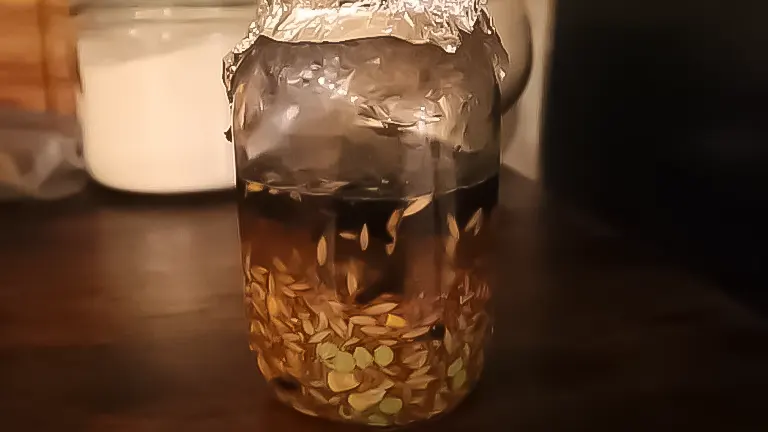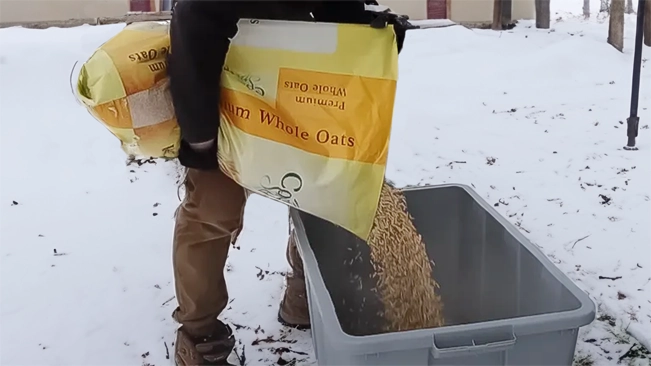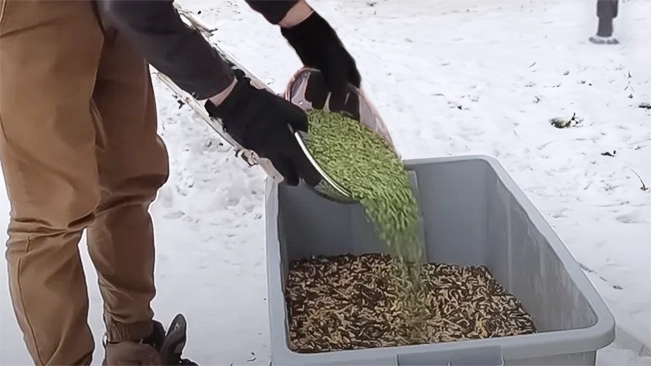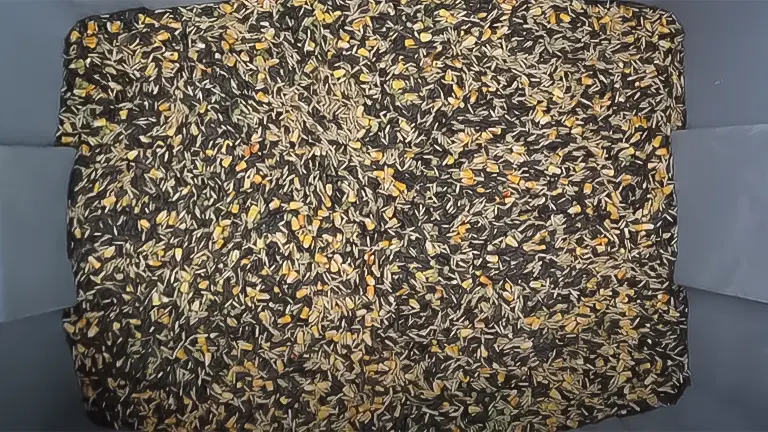How to Make Your Own DIY Healthy Homemade Chicken Feed
- February 20, 2024
- 19 comment
The guide “How to Make Your Own DIY Healthy Homemade Chicken Feed” serves as a thorough manual for those interested in enhancing the nutritional intake of their poultry. It begins with addressing a widespread issue among poultry owners regarding the unsatisfactory quality of store-bought chicken feed, which not only looks unappealing but also seems to lack resemblance to genuine food.

This issue is critical as it is widely accepted that the feed’s quality has a direct impact on the health of the chickens, which in turn affects the quality of the eggs and meat they offer. The guide aims to bridge this gap by providing a healthier, more natural alternative to commercial feeds.
List of How to Make Your Own DIY Healthy Homemade Chicken Feed:
Essentials of a Balanced Chicken Feed
Proper nutrition is vital for chickens, just as it is for all living creatures, fueling their growth and development. A balanced chicken feed comprises five fundamental elements: Carbohydrates, Fats, Proteins, Minerals, and Vitamins, each playing a critical role in ensuring optimal health.

Key Components of the DIY Feed
The guide details a step-by-step process for creating a nutritious and balanced chicken feed mix using readily available ingredients. The primary components of the feed include:
1. Whole Oats
Whole oats are a staple in the formulation of homemade chicken feed due to their rich nutritional profile, which includes a significant protein content, essential energy nutrients, and antioxidants, all of which are vital for the overall health and productivity of chickens. Their affordability makes them an attractive option for poultry owners looking to optimize their feed without incurring high costs.

Oats play a crucial role in not only meeting the dietary protein requirements of chickens but also in providing a sustained release of energy, which is essential for their daily activities and wellbeing. The presence of antioxidants in oats contributes to the immune health of the flock, making them less susceptible to diseases and stress.
2. Whole Corn
Whole corn is a common ingredient in chicken feeds, albeit a subject of debate among poultry enthusiasts due to concerns about nutritional balance and over-reliance on corn in commercial feeds. Despite this, corn’s high caloric content makes it an invaluable energy source for chickens, particularly in colder months when the birds require additional energy to maintain body heat.

This energy boost is essential for sustaining the chickens’ metabolism and ensuring they remain active and healthy during the winter. The inclusion of corn in a balanced diet, therefore, can be strategically beneficial, providing the necessary calories to keep the flock warm and energized.
3. Black Oil Sunflower Seeds (BOSS)
Black Oil Sunflower Seeds, often abbreviated as BOSS, are celebrated for their high protein content, making them an essential component of a nutritious chicken feed. Beyond their protein value, BOSS seeds are rich in oils that enhance feather quality, imparting a shiny appearance and increasing water resistance, which is particularly beneficial for chickens exposed to the elements.

Additionally, the inclusion of BOSS in chicken diets has been linked to increased egg production, making them a favored choice for poultry owners focused on maximizing yield. The nutritional richness of BOSS, including essential fatty acids, supports not only the physical health of chickens but also contributes to their reproductive efficiency.
4. Split Peas
Split peas stand out as another high-protein feed option that caters to the specific nutritional needs of laying hens. Their composition supports the development of muscle and the production of high-quality eggs, critical for hens in their laying period.

The protein found in split peas is essential for egg production and overall health, aiding in the maintenance of strong, healthy birds capable of consistent egg laying.
Additionally, split peas contain vital vitamins and minerals, contributing to a well-rounded diet that enhances the flock’s health and productivity, making them an excellent choice for a balanced and nutritious poultry feed.
5. Flax Seeds
Flax seeds are highly regarded in the composition of chicken feed for their omega-3 fatty acids, which play a significant role in improving the health of chicken feathers and the nutritional quality of eggs. These fatty acids are crucial for feather strength and appearance, ensuring chickens maintain a healthy plumage.

Furthermore, the omega-3 content in flax seeds is transferred to the eggs, enhancing their nutritional profile for human consumption by increasing the omega-3 levels in the egg yolks. This makes flax seeds an invaluable addition to chicken feed, not only for the health benefits they provide to the chickens but also for the direct positive impact on the quality of eggs produced, catering to consumers seeking nutrient-rich food sources.
Additional Tips and Considerations
- The article suggests the option of using organic or non-GMO versions of the ingredients to further enhance the feed’s quality, acknowledging budget constraints as a valid consideration for many keepers.
- It also touches on the nutritional benefits of each component, offering insights into how they contribute to the overall health and productivity of the chickens.
- The creator advises on the significance of supplementing the DIY feed with oyster shells and grit for calcium intake and digestion aid, respectively.
Key Nutrients in Chicken Feed

- Carbohydrates make up the bulk of a chicken’s diet, acting as a rapid energy source. Common sources of carbs in chicken feed include grains like corn, barley, wheat, and millet, providing the necessary fuel for daily activities.
- Fats, or fatty acids, are calorie-dense nutrients that aid in the absorption of fat-soluble vitamins A, D, E, and K, and offer additional energy, particularly useful during the colder months. Sources of fats for chickens include lard and tallow.
- Proteins are crucial for the physical development of chickens, contributing to muscle, skin, and feather growth. Protein sources can be animal-based, such as fish meal, meat, and bone meal, or plant-based, like soybean meal, canola meal, and corn gluten meal.
- Minerals are divided into Microminerals and Macrominerals, with each group supporting various functions such as bone health, and muscle and nerve operations. While grains are often deficient in essential minerals, supplements like Nutri-balancer or oyster shells for calcium can fill this gap.
- Vitamins are necessary for growth and reproduction, with some produced by the chickens themselves and others needing to be supplied through diet and supplements.
For those interested in a deeper dive into the science behind chicken feed nutrients, further reading can offer extensive insights.
Personal Touch and Community Engagement
A notable aspect of the guide is the personal touch added by the creator, including the involvement of their daughter in the mixing process and the mention of their family’s budget considerations. This approach not only humanizes the guide but also makes it relatable to a broad audience.
The guide concludes with an invitation for feedback and discussion, encouraging community engagement and the sharing of alternative recipes or improvements. This openness to dialogue and exchange of ideas fosters a sense of community among readers and viewers.
Related Articles:
- Best Bedding For Chickens
- Best Safe Chicken Coop Heater
- 8×8 Chicken Coop Plans
- Turning a Shed Into a Chicken Coop
- How to Make a Chicken Coop Out of Pallets
- Best Sand for Chicken Coop
- How To Insulate a Chicken Coop
- How To Heat a Chicken Coop
- How To Keep Water from Freezing in Chicken Coop
- How to Build a Chicken Coop
- How To Build Chicken Nesting Boxes
- How to Raise Happy and Healthy Chickens in Your Backyard
- When Can Chicks Go Outside? Timing and Tips for a Smooth Transition
- 12 Reasons why Ducks are Better than Chickens
- Best Automatic Chicken Coop Doors 2024: Expert Reviews & Buyer’s Guide
- Best Fans for Chicken Coop 2024: Effective Cooling Solutions Reviewed
Final Thoughts
Overall, the “How to Make Your Own DIY Healthy Homemade Chicken Feed” guide provides a valuable resource for those seeking to improve their chickens’ diet through a hands-on, customizable approach. Its emphasis on natural ingredients, combined with practical advice and personal insights, makes it an engaging and informative read for both novice and experienced chicken keepers.
Frequently Asked Questions
- What are the benefits of making my own chicken feed?
Creating your own chicken feed allows you to control the quality and composition of the feed, ensuring it’s free from unwanted additives. It can also be more cost-effective and tailored to meet the specific nutritional needs of your chickens. - Is it cheaper to make my own chicken feed?
Yes, in many cases, it can be cheaper to make your own chicken feed, especially if you buy ingredients in bulk or have access to them at lower costs. However, prices can vary based on location and the ingredients used. - Can I use organic ingredients in my DIY chicken feed?
Absolutely. You can choose organic versions of the ingredients listed, such as whole oats, corn, black oil sunflower seeds, split peas, and flax seeds, to ensure your feed is organic. This might increase the cost but will ensure your chickens are eating organically. - How do I ensure the homemade feed meets my chickens’ nutritional needs?
To meet nutritional needs, balance the feed’s protein, fat, and carbohydrate levels according to the age and production stage of your chickens. Include a variety of ingredients to cover the spectrum of vitamins and minerals they require. - What is the ideal protein content for homemade chicken feed?
The ideal protein content varies; laying hens generally require feed with about 16-18% protein. Adjust the proportions of high-protein ingredients like black oil sunflower seeds and split peas to achieve this. - How do I store homemade chicken feed?
Store your homemade chicken feed in a cool, dry place in airtight containers to prevent spoilage and protect it from pests. Proper storage will maintain its nutritional value and freshness. - Can I ferment the DIY chicken feed for additional benefits?
Yes, fermenting chicken feed can improve its nutritional value, making vitamins and minerals more accessible and aiding in digestion. Soak the mix in water for 24-48 hours to ferment it before feeding. - How often should I feed my chickens with the homemade feed?
Feed adult chickens twice a day, morning and evening, ensuring they have enough feed to consume within 20 minutes to prevent overeating and waste. - Do I need to add supplements to the homemade feed?
Depending on your feed composition, you might need to add supplements such as calcium or grit. Oyster shells for calcium and commercial grit are commonly added supplements to support eggshell quality and digestion. - Can all types of chickens eat this homemade feed?
This homemade feed is formulated for adult laying hens. Adjustments might be needed for chicks, broilers, or chickens with specific health needs, focusing on their particular nutritional requirements.
We value your input and experiences! If you’ve tried making your own DIY Healthy Homemade Chicken Feed based on our guide, we’d be thrilled to read about your journey in the comments section below. Share your modifications, results, and any tips you’ve discovered along the way. Your personal insights could greatly benefit others in our community looking to provide the best nutrition for their flock. Let’s help each other make informed, healthy choices for our chickens!

Edward Smith
Forestry AuthorWoodworking is about more than crafting; it's a harmonious connection with nature, mastering tools, and preserving our environment. I'm here to share my knowledge and experiences with you, forging a future where we can embrace wood's beauty and utility while safeguarding our forests' health and diversity.
19 comments
Thank you for your feed mixing contents. May you please send me mixing proportions.
Mbewe Samuel
February 28, 2024 3:57 pmThanks for the information it's a good mix to make healthy chickens
Doreen Ntanzi
February 28, 2024 3:32 pmThank for informative information on chicken feed. I am definitely going to try it out. The advantage being that I am in control of what I feel my chicken flock.
Sebina Rasenyalo
February 27, 2024 10:47 amThank you for information
Lawrence Fraser
February 26, 2024 7:13 amI like the article because I'm new in poultry farming
Chrispine Malinda
February 26, 2024 6:29 amWhat's the mix ratio? Hemp seeds way better than flax.
Michael Galea
February 26, 2024 1:35 amThanks for your article! Are you using dried split peas? And I noticed you didn't use alot of it in your mix
*ab
February 25, 2024 1:26 pmI'm happy for you
Abubakar
February 25, 2024 7:30 amIt would be useful to mention the weight percentages of the above food items suggested
T.H.J. Pieters
February 24, 2024 2:04 pmCorn and oats can get for .08 pd but the rest is crazy expensive.
Arthur Perrea
February 24, 2024 11:39 amGood idea it is working pretty well
Odhiambo George
February 23, 2024 1:39 pmVery good idea for a beginner and also to save on cost Can i have a reply of how to mix and grind and also quantity
Mohamed Moosa
February 23, 2024 9:21 amYou do not have to grind your feed chickens can eat it whole. They use grit to grind their food (set a bow out and let them free feed or Choice )it in their system. But if you feeding (Baby Chicks, that’s a different story)and you give adult chickens a half a cup daily.
Gary P
February 28, 2024 3:30 amMix your grains and seeds in balanced proportions, then grind to a coarse powder using a grain mill or blender. Adjust quantities based on your flock's size and needs. Remember to make enough feed to last for one month to ensure freshness and optimal nutrition for your chickens.
Edward Smith
February 26, 2024 6:48 amVery good combination of an organic feed diet, but it seems more expensive, looking @the whole grain involved
Jonathan
February 23, 2024 2:19 amThanks .That is breathtaking. Farmers who start from scratch feeds are too expensive and this is only solutions.
Sheke Ngxongo
February 22, 2024 3:47 pmVery good combination of a special organic feed diet













What are the mixing portions of each grain used to make the DYI chicken feed. Please
Graham Gibb
March 12, 2024 1:19 amFor a balanced DIY chicken feed, consider mixing 30% whole oats and 30% whole corn for energy and fiber, 20% split peas or lentils for protein, 10% black oil sunflower seeds for protein and healthy fats, and 10% flax seeds for omega-3s, important for feather and egg quality. Adjust based on your chickens' needs, and ensure access to grit for digestion and oyster shell for calcium, especially for layers. Supplementing with vitamins and minerals can help fill any nutritional gaps.
Edward Smith
March 25, 2024 6:24 am